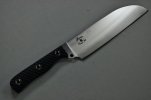- Joined
- Jun 15, 2013
- Messages
- 114
This may be an odd topic to post on this particular forum, as opposed to the more general forums, but I've come to value the thoughts and opinions of my fellow SRK fans.
After picking up a couple Swamp Rat and Busse knives, I realized how underwhelming my kitchen knives were in comparison. These are the knives that I use most often and might as well get them upgraded to be as good as my field knives.
What distinguishes a kitchen knife from a field knife?
Agree that they are really interchangeable. I could use a paring knife as an EDC or one of my choppers to make potato salad, but in general there still seems to be different categories we typically put them in.
Is it just blade thickness? Seems like kitchen knives are typically .10" thick and often around .05" thick.
Doubt kitchen knives are expected to endure the use/abuse we expect of our field knives, which explains the thinner blade and expect should also help when looking for paper thin slices or peeling an apple or potatoe.
After picking up a couple Swamp Rat and Busse knives, I realized how underwhelming my kitchen knives were in comparison. These are the knives that I use most often and might as well get them upgraded to be as good as my field knives.
What distinguishes a kitchen knife from a field knife?
Agree that they are really interchangeable. I could use a paring knife as an EDC or one of my choppers to make potato salad, but in general there still seems to be different categories we typically put them in.
Is it just blade thickness? Seems like kitchen knives are typically .10" thick and often around .05" thick.
Doubt kitchen knives are expected to endure the use/abuse we expect of our field knives, which explains the thinner blade and expect should also help when looking for paper thin slices or peeling an apple or potatoe.

